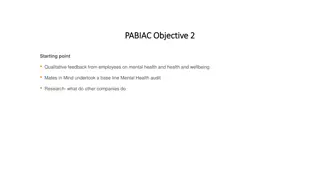Understanding Mental Wellbeing Scales and Application in Practice
Comparing practitioner clinical judgement and standardized scores in mental wellbeing assessment reveals correlations impacting therapy selection. Collaborative discussion between clients and clinicians is vital for identifying focus and service delivery. Progressions are depicted through hierarchical taxonomies like Maslow's Hierarchy of Needs. The application of mental wellbeing models in practice emphasizes the importance of qualitative data and facilitating choice-making.
Download Presentation

Please find below an Image/Link to download the presentation.
The content on the website is provided AS IS for your information and personal use only. It may not be sold, licensed, or shared on other websites without obtaining consent from the author. Download presentation by click this link. If you encounter any issues during the download, it is possible that the publisher has removed the file from their server.
E N D
Presentation Transcript
The Warwick & Edinburgh Mental Wellbeing Scale (WEMWBS) 3.2.4-WEMWBS.pdf (ocagingservicescollaborative.org)
Noticing correlations Comparing practitioner clinical judgement and scores generated by standardised tools found correlation between the tools, and correlation between clinician judgement about appropriate levels of working and indicative scores Mostly 1s in scoring = Level 5 therapy mostly selected Mostly 2s in scoring = Level 4 therapy mostly selected Mostly 3s in scoring = Level 3 wellbeing mostly selected Mostly 4s in scoring = Level 2 wellbeing mostly selected Mostly 5s in scoring = Level 1 wellbeing mostly selected However, discussion between client and clinician, capturing qualitative data and facilitating choice-making is vital to identify focus & mode of service delivery, and encourage participation.
Ladders of progression Progressions are often expressed through hierarchical taxonomies: Maslow s (1943) Heirarchy of Needs image credit: https://www.simplypsychology.org/maslow.html Bloom et al (1956)























